How to Select aGun Cleaning Kit
By Dan Kidder |Like any machine, a gun needs to be properly cared for if we expect it to work when we need it to. This means a cleaning kit is a necessary part of owning a firearm no matter if you’re a casual owner or a dedicated competition shooter.
But what should you have in your cleaning kit and what makes a good cleaning kit? There are a number of factors to explore, so let’s look over some of the basics before getting into a few recommendations.
Cleaning kits allow you to keep your gun working by getting rid of build up and other dirt that can impact your gun’s performance. They will feature brushes and other cleaning tools, some of which are caliber specific.
Let’s get into the “How” and “Why” of cleaning your gun in order to understand the value of a cleaning kit.
Selecting a Cleaning Kit: Reasons and Tools
Before we get into the tools you’ll need to take care of your gun, we first need to talk about why we’re cleaning a gun at all. We’ll also cover some pitfalls to avoid when we do clean our guns.
Why Clean Your Gun?
If you’re not dropping the firearm in mud, water, or some other environmental hazard why should you clean it?
Well, firearms produce a lot of contaminates when they are used. There is fouling that is produced when the bullet and gasses are pushed through the barrel. This leaves bits of copper, lead, and carbon stuck in the rifling of the barrel, if there is any.
This fouling will impact performance by making it harder for the rifling to work on the bullet. Additionally some propellants are corrosive. Corrosive powders have a long shelf-life but will prematurely degrade your barrel if they are not cleaned away.
Moving from the barrel to the chamber, fouling is found in the form of carbon build up. A lot of modern firearms can go without cleaning for thousands of rounds, but eventually that build-up will induce malfunctions.
This is even more likely with lower cost firearms. To ensure that the firearm is running properly it should be cleaned either on a semi-regular basis or when malfunctions occur in training. If you’re using corrosive ammo, you should at least rinse the barrel out with water after you are done shooting.
Rinsing the barrel will neutralize the salts in the powder, preserving the longevity of your barrel life as long as it is thoroughly dried. Additionally, if you plan on storing the firearm for a long time, the weapon should be properly cleaned, and lubricated before being put in storage to combat rust.
This brings us to the dangers of cleaning.
Improper Cleaning & Over Cleaning
There are two major concerns when cleaning the gun. The first is simple, improper cleaning.
Improper cleaning can happen if we are too rough when we are cleaning or are using our tools incorrectly while cleaning.
Improper cleaning can result in damage to the barrel crown, which will impact accuracy, or cause undue wear on other parts of the gun. If you’re dealing with a gas-operated firearm you can even damage the gas-port if your tools are harder than the material of the port.
This can be avoided with properly heat treated and quality parts while using appropriate materials in our tools, but the risk is still there.
The next major concern is over cleaning the gun. Stripping the gun and cleaning it heavily each time you use it will cause increased wear on the gun. Many people think a gun needs to be cleaned after each use, but this mostly comes from military training.
Military training emphasizes regular weapons cleaning, but this is specific to military goals. Weapons cleaning is helping to familiarize recruits and soldiers with gun maintenance, reducing the burden on armorers who have to care for dozens or even hundreds of weapons, and simply making sure soldiers have tasks.
Since we don’t need to keep ourselves busy, cleaning should be done on an “as necessary” basis. You don’t change the oil of your car every time you drive it and you should not be cleaning your gun every time you use it.
This does not apply if corrosive ammunition is used or if the firearm is an antique or collectible. These factors require a little more effort when it comes to maintaining firearms.
Cleaning Supplies
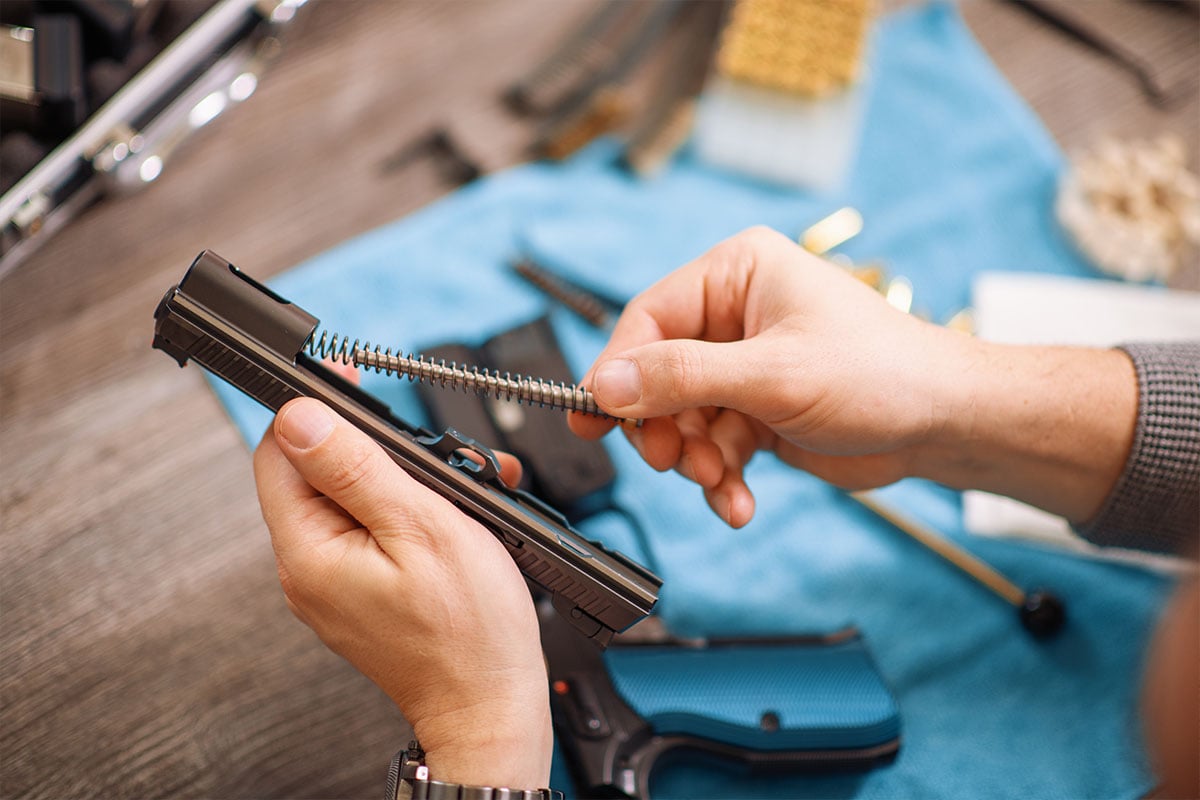
Cleaning kits come with various tools and accessories, but what do we need in a kit to make it good? Let’s look at what should be in a cleaning kit so we know if some kits are designed as primary kits or supplements.
Before we look at the different tools in a kit, be sure you are wearing gloves when handling solvents and similar chemicals while cleaning and have something like a towel or mat to place the disassembled firearm on.
These precautions will help prevent you from damaging your skin and make it easier to clean up your work space.
If you choose to not wear gloves, wash your hands to prevent the oils in your skin from getting into the gun. Wash your hands after handling solvents and similar chemicals to prevent skin damage.
1. Cleaning Rod
If you are serious about owning a firearm you need a cleaning rod. Cleaning rods are the backbone of every cleaning kit. The rod itself can be in multiple pieces that screw together to get the desired length.Cleaning rods are made of a variety of materials that are softer than steel. This makes it less likely to damage the barrel. They are extremely important to maintenance because many of the other tools we’ll use to clean the barrel will attach to a cleaning rod.
Some say that you should only pull with a cleaning rod, but you can push or pull while using the rod. You can scrub the barrel with back and forth motions, but you should do what you feel comfortable with.
This push/pull method does not apply with an alternative tool called a flex cable. With a flex cable you can only pull the attachments through the barrel because the cable is not rigid enough to push.
There is another tool used for quick cleaning called a bore snake, but we’ll cover this in another section.
2. Brushes
Bronze Barrel Brush:
Bronze brushes are our first tool to use when cleaning. When attached to the cleaning rod, bronze brushes are used to break up tough carbon buildup. You’ll want to push or pull the brush through the barrel in one direction.
Usually the direction the bullet travels is recommended for which direction you push or pull the brush. This supposedly impacts barrel life, but just be careful when using the brush on the barrel.
Brushes are caliber specific. Do not use an oversized or undersized brush on your barrel, this will increase the likelihood of damage since it will either have too much wiggle room or require more force to fit the brush in the barrel.
Be sure to apply a solvent to your brushes to help break up the carbon.
Nylon:
Nylon brushes are for more delicate areas of the gun or light cleaning. If you think you might damage a sensitive area of the firearm, you should use a nylon brush just to be safe.
They are used on areas that are more recessed or “carved out” This means locations like the chamber, etc.
Nylon is generally more forgiving than bronze, but be sure to use the appropriate sized brush either way.
Other Brushes:
There are additional brushes you can use to clean other parts of the gun. These have a wider variety of bristles so be sure to use the correct one to avoid marring the gun’s finish. Do not use them on the barrel as they are not designed as a barrel brush.
3. Cleaning Jags/Patch Holder
Next we have two similar tools that you use after the bore brushes, jags and patch holders. These tools take different approaches to the same process.
After cleaning out your barrel with a brush, you should use a patch to apply additional solvent to the inside of the barrel. The same method can be used with a dry patch to remove excess solvent from the barrel.
Then the patch is either pierced with the jag (an attachment for your cleaning rod) or passed through the loop in a patch holder (an attachment that looks like a long eye of a needle).
Push the patch through the bore once and then replace the patch for each pass. This prevents dirt and debris from being re-deposited after it was cleaned out. Patches are cheap so using multiple patches, some of which are designed to be reused, are necessary additions to your cleaning kit.
This process will clear out any residual carbon in the barrel and allow you to try the barrel to prevent rusting.
4. Swabs
A great addition to your cleaning kit are specialty cotton swabs. These swabs have a long wooden handle that ends in a swab. They are disposable and can be used in detailed cleaning or quick passes down a barrel.
It’s not necessary to have them included with a cleaning kit, but they are affordable supplements.
5. Bore Mops
Once a barrel has been cleaned enough (clean patches on a pass-through) the barrel needs to be protected from other environmental factors. This is done by applying gun oil.
Applying it can be done easily with a patch but if you want a consistent, controlled amount of gun oil, you should use a bore mop.
A bore mop is similar to a bore brush but it applies oil rather than a cleaning solvent. Bore brushes are caliber specific and will put a light coat of oil in the barrel. This helps keep the barrel “healthy” by preventing rust.
6. Solvents & Degreasers
We’ve already mentioned solvents, but let’s look at what they are and what they do.
Solvents are chemicals that break-up carbon and debris in the gun. They allow for easier cleaning and will save on the effort you’ll have to use when scrubbing the barrel.
Solvents are also paired with degreasers. Degreasers will help strip the lubrications from gun parts, allowing for a fresh coat to be applied after the parts are cleaned.
You don’t want to degrease your parts too often because this can cause too much wear on the parts. After a part is lubed, it doesn’t take a lot to keep the gun running and over lubricating a part can cause problems.
Thankfully, solvents and degreasers are usually clearly labeled to avoid confusion, although Hoppe’s No. 9 is a popular brand.
7. Lubricants
Like any machine with moving parts, lubrication is a necessary part of long term usage. This prevents the parts from grinding against each other, causing unnecessary damage. A firearm can be shot “dry” but for extended uses it should be lubricated.
Keeping a gun “dry” or without lubricant is a better option for areas that experience very sandy environments. The lubricants can cause the sand or similar particles to stick to the parts, inducing a malfunction.
If this is not an issue, and you do plan on shooting the gun regularly, you should keep the gun lubricated. There are two types of gun lubricants: liquid and grease.
Liquid:
Liquid gun lubricants or gun oils are the best general purpose lubricant. They’ll work with very tight tolerances and loose tolerances on pistols, rifles, and shotguns.
Products like Slip 2000 or gun oils from Hoppe’s, Ballistilol, etc. will keep your gun running for a long time. If the gun is starting to feel sluggish, it might be time to add more lubricant.
Liquid lubricants also perform better in colder environments than grease.
Grease:
Grease is less universal in its usage. Gun greases can cause more problems if they are applied too heavily to the internals of the gun.
Gun greases tend to work better in guns with looser tolerances like Glocks and AKMs. While this might be beneficial for those types of firearms, liquids are the recommended lubricants when compared to grease.
No matter what your preferred lubricant style is, you should use purpose built lubricants. These are designed for use in guns while being non-toxic compared to more expedient lubricants like motor oil.
8. Bore Snakes
Bore snakes are a quick cleaning method. They are designed for preventative cleaning if you don’t have time to sit down and do a proper cleaning of the gun.
It combines patches and brushes into one long coil. Some bore snakes are designed for one or more calibers.
To use a bore snake, thread the weighted end down the barrel after applying a cleaner to the bore. Then pull the bore snake through to clean out the bore. This is a good tool to clean a barrel after a range session.
It doesn’t replace all your other cleaning tools but it will make it easier to clean later by not letting any debris or carbon sit in the barrel and solidify.
9. Additional Items
These items are not necessary for a cleaning kit but will make cleaning easier.
Gun Mat:
A decent gun mat can help keep parts in order and keep your working area clean. Avoid getting solvents and oils everywhere with a simple addition to your cleaning kit.
Cleaning Stand:
If you’re working on long guns, a good cleaning stand will help a lot. That way you won’t have to try and hold onto the gun while trying to use the cleaning rod and other equipment. If you are going to be working on a lot of guns, this will save you time.
There are few other items you could add like a crown protector, but they are not a necessity.
Cleaning Kits
Now that we know what can go into a cleaning kit, let’s look at some options available to us. Keep in mind, many of these are either going to be caliber specific, or are just the bare necessities for a cleaning kit.
Real Avid Gun Boss Pro Universal Gun Cleaning Kit
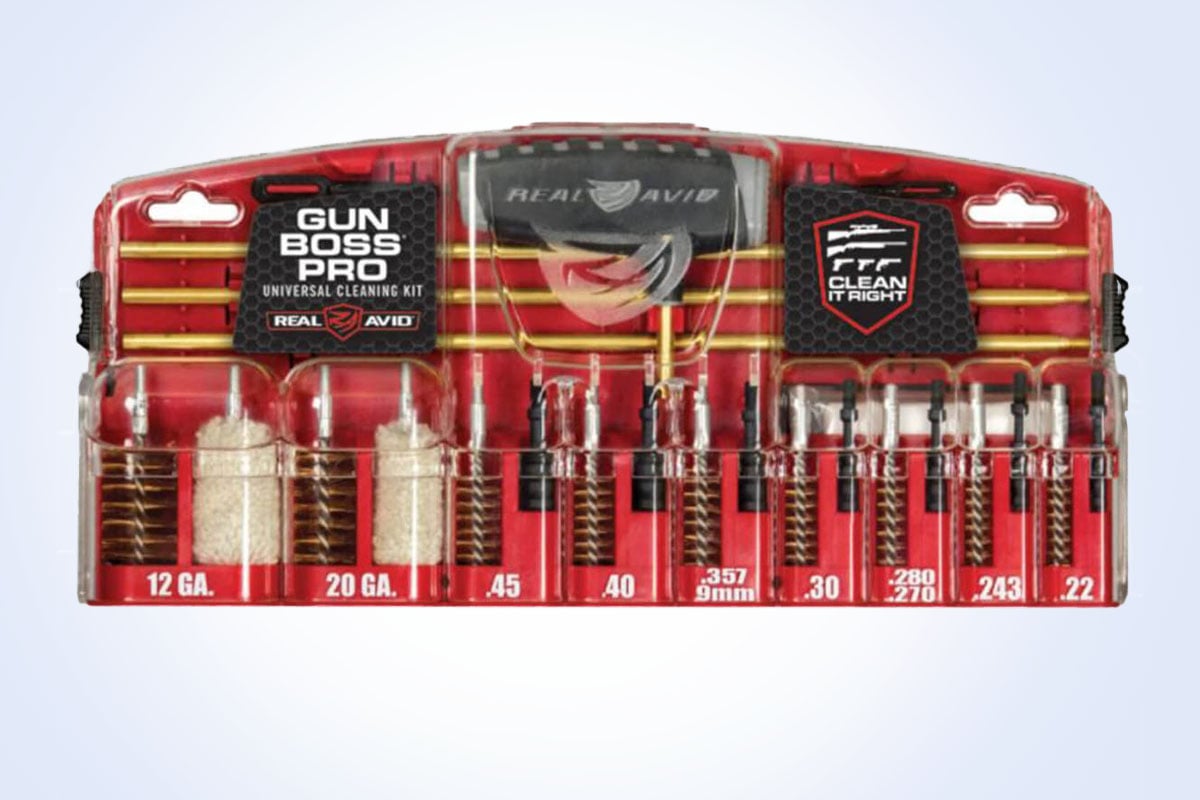
This Gun Boss Pro Universal Cleaning Kit is the best value for the ease of use and the tools provided.
Not too expensive, it comes with a T-handle attachment for your three-piece brass cleaning rod with 9 different brushes. There are also 7 different bore jags, 2 mops, 2 nylon patch holders, and 50 included patches.
Each caliber is clearly labeled so there is no mistaking which piece is for which caliber. Each piece snaps securely in place so it doesn’t fall out and get lost in your work space.
This universal kit will work on pistols, rifles, and shotguns when used with the appropriate caliber attachments.
Hoppe’s Black Gun Cleaning Kit
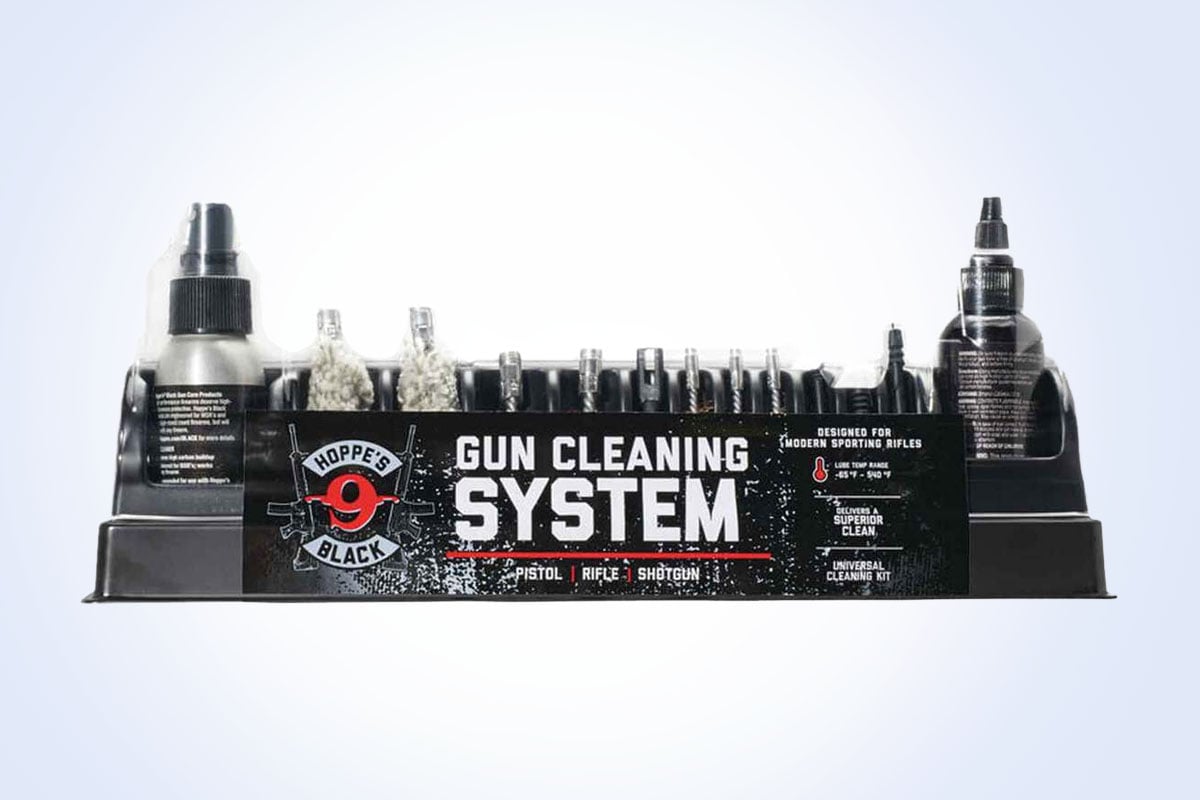
Designed for Modern Sporting Rifles (MSRs), this cleaning kit will work with AR-15s and other high round count firearms.
It comes with a three-piece aluminum cleaning rod, 2 ounces of gun cleaner, and 2 ounces of precision oil. There are also jags and bronze brushes for calibers ranging from .22 to .38 in addition to 12 and 20 gauge.
This allows you to clean pistols, rifles, and shotguns with ease. The inclusion of gun oil and cleaner make this a great first time gun cleaning kit.
Strike Industries Gun Cleaning Brush Kit
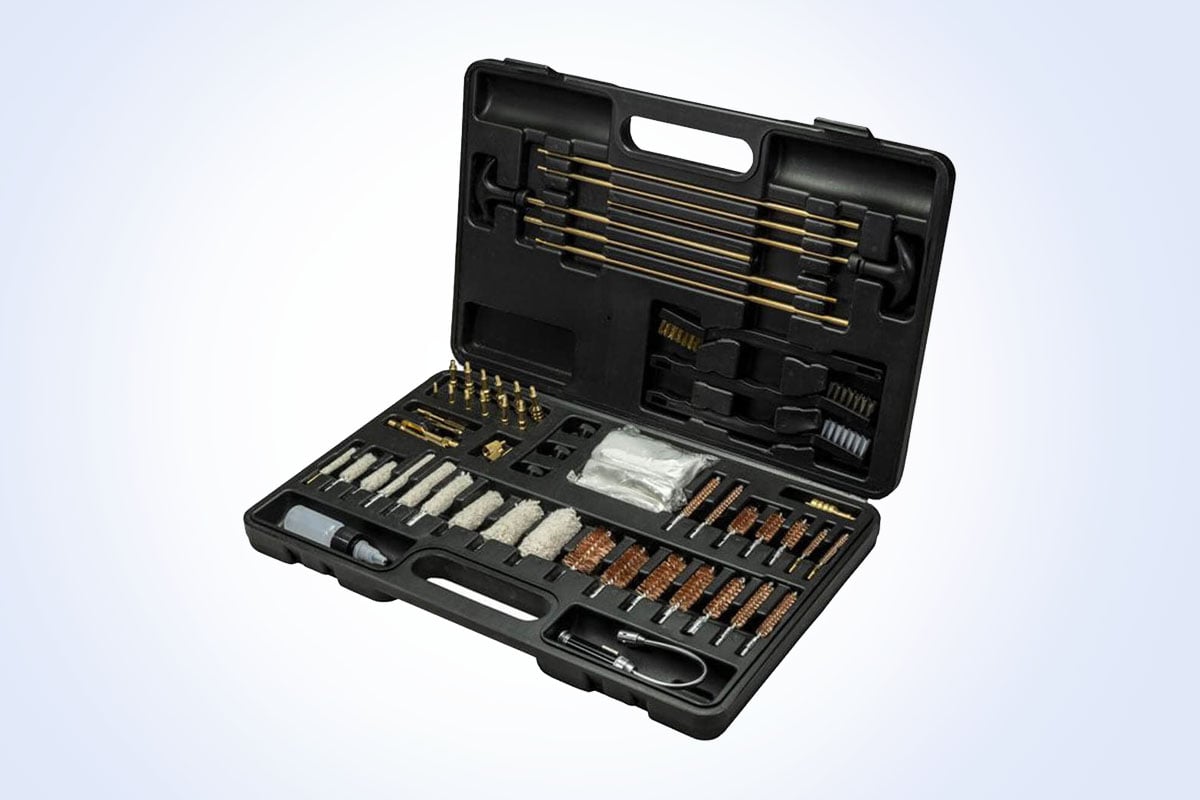
A more extensive option, this Strike Industries universal cleaning kit is on the more expensive side, but offers a wider variety of jags, mops, and brushes.
This kit has everything you’ll need to clean your guns, with the exception of an included solvent and gun oil. Every other tool is included.
It has 14 individual brushes with their corresponding caliber engraved on each. Additionally there are 9 mops and 12 brass jags for applying oil and solvents. There are 4 brass patch holders and a single 50 caliber powder jag that is not labeled.
An empty oil bottle and a LED flex flashlight are included with 3 muzzle guards and 3 brass cleaning rod adapters. The cleaning rod itself is up to 28 inches and comes in 6 pieces. Additional cleaning tools include three plastic handled brushes.
These brushes come with nylon, steel, or brass bristles. These round out a very extensive cleaning kit that is perfect for most of your cleaning needs.
Hoppe’s Pistol & Rifle Gun Cleaning Kits
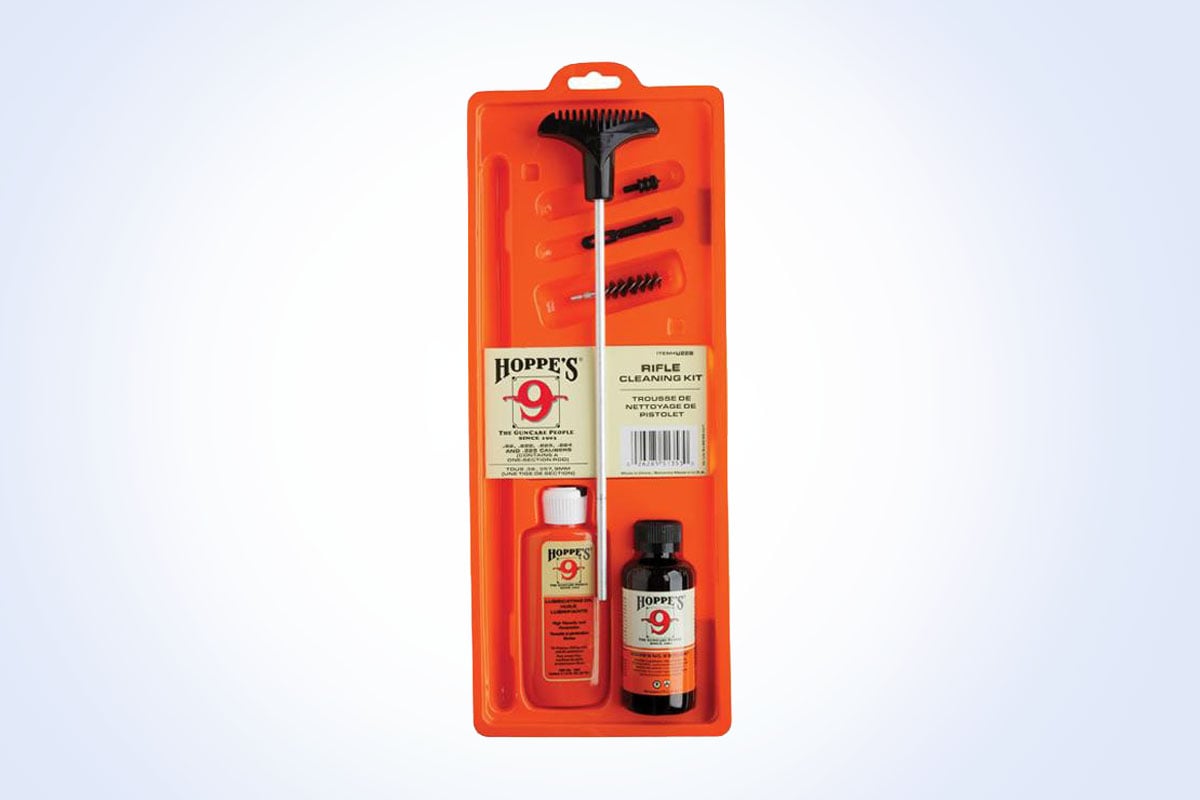
This minimalist kit is caliber specific. If you have one pistol or want to slowly build up your cleaning kits, this is a very affordable option.
It includes a single nylon brush, jag, patch holder, and once piece cleaning rod. A bottle of Hoppe’s No. 9 bore cleaner and a bottle of Hoppe’s lubricating oil are also included, so you don’t have to buy any additional materials initially.
If you need a quick cleaning kit for one particular firearm, this is the one to grab if you forgot your main kit somewhere.
Otis 5.56 NATO Gun Cleaning Kit
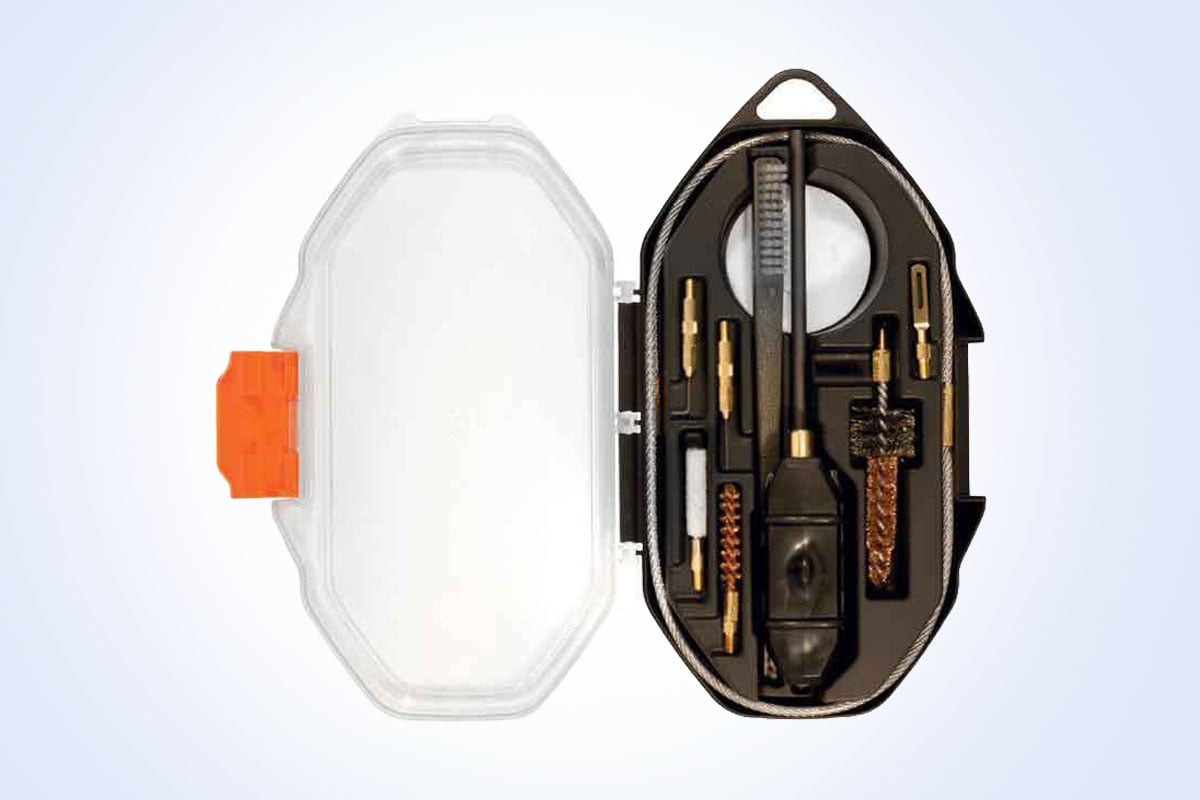
This Otis cleaning kit is great to keep in your range bag. Designed for .22 Long Rifle, .22 Caliber, and .30 caliber chamberings, this kit features a small, portable kit with the basic tools you’ll need to keep your rifle running.
This kit includes a bronze bore brush, chamber brush, and mop in the selected caliber. Each brush is marked on the stem.
A flex cable is included with an all purpose brush, an obstruction remover, and additional rods. A set of bent and straight picks are included for more precise cleaning.
You will have to provide your own oil and solvents, but this affordable kit offers more than kits with a lower price point. Compact and easy to store, you’ll be able to take your cleaning kit wherever you go without having to carry a larger universal kit.
Conclusion
Like most things in the firearms world, what you need will determine which kit you get. Simple kits like the Hoppe’s cleaning kits are great for those who might have one gun or might need to loan out a cleaning kit. Others might need the Strike Industries universal kit to care for multiple guns in multiple calibers.
Keeping your guns in running condition is extremely important to safe handling, as this will help cut down on malfunctions while increasing general reliability. This is especially important if the gun you are cleaning is your primary self-defense firearm.
Learn your exact needs and select the appropriate cleaning kit to fit those needs.